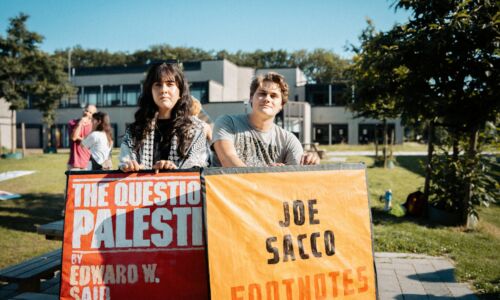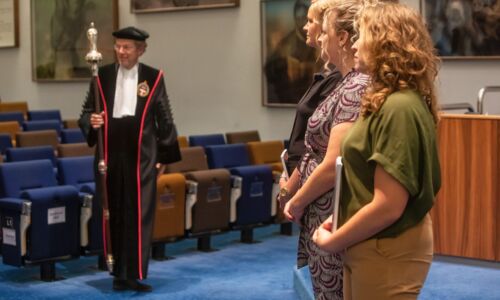The rising star of Sara Issaoun
-
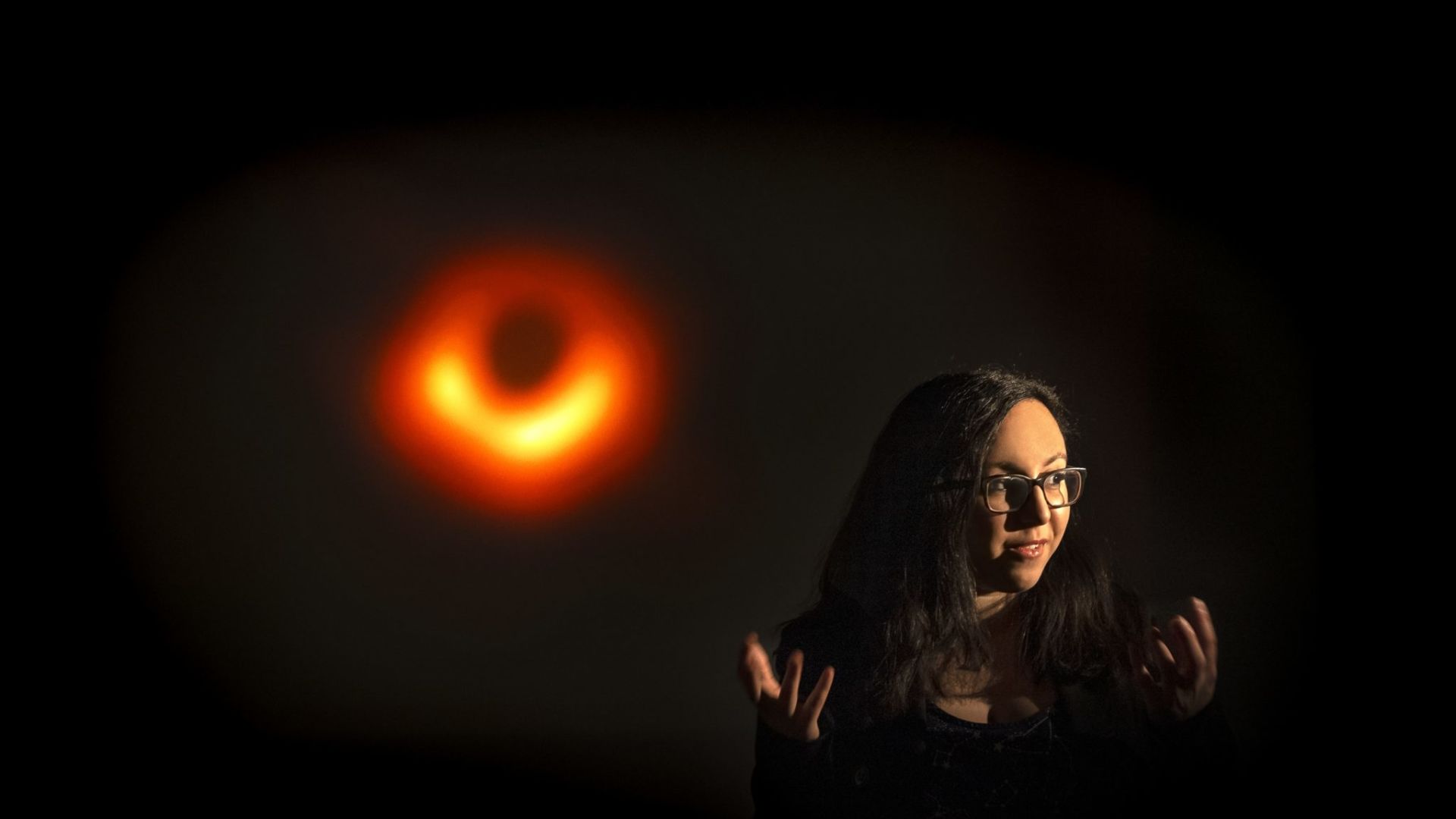 Photo: Julie de Bruin
Photo: Julie de Bruin
She’s published in the Astrophysical Journal, appeared in The New York Times, and was involved in the most important astronomical breakthrough in light years: the first photograph ever of a black hole. And PhD student Sara Issaoun is only 25 years old.
Sarah Issaoun turns her laptop around. The Skype screen shows her office in Boston, Massachusetts. Bare, white walls, standard office furniture: nothing to suggest that this is an office at the Harvard Center for Astrophysics, at the heart of what is perhaps the most prestigious university in the world. Radboud PhD student Issaoun (25) is here for a one-month work visit, not for the first time during her studies. ‘This building was once part of a Catholic school,’ she says. ‘It’s not a very nice building: it’s quite old, with lots of narrow hallways.’
The Huygens building is better?
‘Yes, much more beautiful, ha ha.’
Many researchers dream of working at a university like Harvard. Can you talk a little about what it’s like to actually be there?
‘It’s not that different from home. The facilities and coffee are not that great, actually. The people who work here, they are the ones who make it so special.’
You get to meet world-famous astronomers at the coffee corner?
‘Yes. My building is home to a couple of Nobel Prize winners, so there’s always the chance of running into them in the hallway. Authors of the study textbooks I used as a student, authors of famous publications, speakers of famous lectures: they’re all here.’
Whereas for your average scientist a visit to Harvard represents a major milestone, for Issaoun it’s not that big a deal. Her career has taken off at a dizzying speed. Last January, she was the main author of a much discussed paper on the orientation of the Earth in relation to the black hole at the centre of the Milky Way, Sagittarius A*. And in April, she made the world news as team member of the Event Horizon Telescope (EHT) consortium, with the first photograph of a black hole.
‘My building is home to a couple of noble prize winners’
A week after her visit to Harvard Issaoun joins VOX for an interview in the ‘much more beautiful’ Huygens building. We’d like to know how a 25-year old gets to boast of such impressive academic exploits. How did she so quickly graduate from dreamy child to astronomy super star? From the home she shares with her parents in Arnhem, Issaoun has brought her telescope. A massive device, nearly a metre high, and a present from her father for her twelfth birthday. ‘A gift from Singapore,’ she explains. ‘My father immediately thought of me when he saw it.’
The telescope
Sara Issaoun was eight years old when she was given an assignment at her primary school in Montreal. To use cardboard to create our solar system, including all the planets and the sun. This school assignment about strange, faraway planets, made a deep impression on her. That same day, Issaoun went to the local library with her mother. They came home with a pile of fifteen children’s books on astronomy, and little Sara devoured the books full of photographs of planets and nebulae. From that time onwards, Issaoun knew she wanted to become an astronomer.
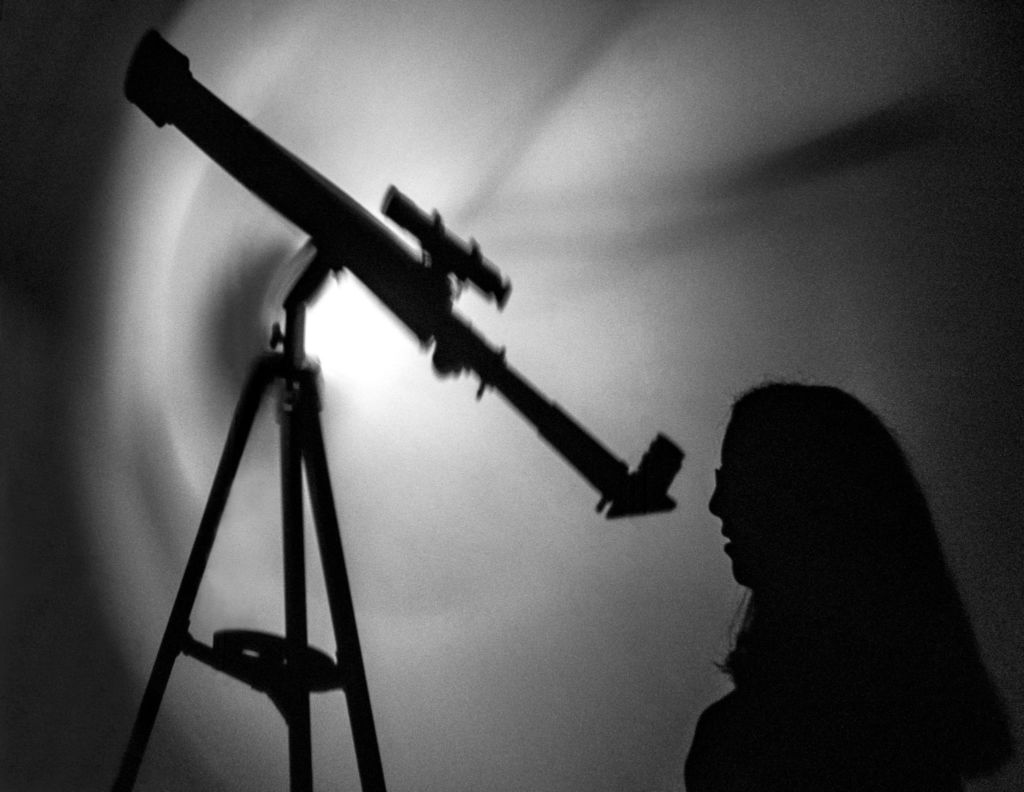
The telescope turned out to be a well-chosen gift. Young Issaoun often took it along to the St-Benoît Park, close to her house. There she spent hours staring at faraway galaxies.
Is your work as astronomer what you imagined as a child?
‘No, not at all. As a child, I thought astronomers spent their time looking through telescopes and photographing stars. But during my studies, I learnt that astronomers study space using other types of light: radio and infrared rays. These are collected using large dishes that translate the light signals into data. I primarily work with data and computers, not with a telescope.’
Can you explain exactly what you do with these data?
‘When we make observations with our telescopes, what we’re doing is collecting a huge set of data. For the photograph of the black hole, for example, we used five petabytes of data – comparable to the memory capacity of five thousand laptops. These data consist mostly of noise. We then create models to account for all the possible sources of this noise, such as disturbances caused by the telescope itself, or the weather circumstances above the telescope. We then delete these data, and what we are left with is the signal we’re looking for.’
Were you disappointed when you discovered the work was very different from what you imagined as a child?
‘No, never! I never had any doubts. Imagine: we get to study objects and events that are so far away we cannot see them with the naked eye, and we try to understand what they tell us about our world. This is what’s always inspired me.’
You find it so easy to explain your passion for astronomy. Is this something you thought about a lot?
Issaoun laughs. ‘I’ve been asked this so often. Mostly by my parents. They would ask me: How can you be so attached to a subject you chose when you were 8? Despite the fact that they’ve always supported me, they find it strange that I’ve never changed my mind. A lot of people find it strange, by the way. I chose something at age 8, and now that I’m 25, it’s still exactly what I’m doing.’
The email
Heino Falcke is a busy man. He’s a professor, the brain behind EHT, and a figurehead for the Radboud University Astronomy Department. In other words: many people vie for the Professor’s attention.
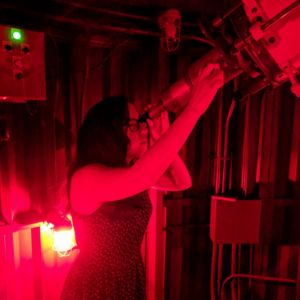
Luckily, this is something Issaoun is blissfully unaware of on the morning of 3 January 2014, in the middle of the Christmas holidays, as she presses ‘Send’. ‘I am staying in the Netherlands for three months in the summer,’ she wrote in her email to Falcke. ‘I would like to use a part of my vacation to volunteer in current research in physics.’
Issaoun’s parents moved to Arnhem for work reasons when she was 14. Issaoun came along, but a few years later she returned to Canada to study. She hoped to put her summer months in the Netherlands to good use. ‘I basically looked up the email addresses of astronomers in the Netherlands, and asked whether they happened to have a project I could join in,’ says Issaoun. Sacrificing your summer to do volunteer work may be a normal thing to do in North America, but it’s certainly unusual in the Netherlands.
This may have been the reason why Falcke responded so quickly. Exactly eight minutes later, the answer reached Issaoun’s mailbox. ‘Sounds interesting,’ Falcke wrote. Could she send him her CV?
Issaoun really got lucky. Falcke had just completed the preparatory phase of a large-scale worldwide collaboration project. Its goal – to capture the event horizon of a black hole – was something many believed to be impossible. The black hole they wanted to photograph, M87, was located 53.5 million light years (approximately 500 trillion kilometres) from Earth. Kind of like photographing the width of the eyebrow of a person 40 kilometres away.
But Falcke knew what he was doing, and he could certainly use the help of an enthusiastic student with a solid background in physics. In the summer of 2014, Issaoun began working as a volunteer on EHT, the gigantic project that simultaneously combined images from eight telescopes from Europe to South America and Antarctica to photograph M87. She enjoyed it so much she decided to do a Master’s programme and later a PhD in Nijmegen under Falcke’s supervision. Issaoun’s career as astronomer was launched.
The photograph
April 2019. The lights dim in the press room of the European Commission. This is the moment everyone’s been waiting for, and which has brought the international press here today. ‘I never believed this black hole was as big as people said it was,’ says Heino Falcke in the microphone. ‘Until we saw … that!’ Here it is then. The first photograph of a black hole appears on the screen. The audience bursts into applause.
Sara Issaoun joins in. Together with her team, she leaves the press conference, only to run into a wall of journalists. Requests for live interviews are rolling in steadily. Issaoun ‘takes on’ the newscast of the international French TV channel France 24 – French is her mother tongue. On Twitter #EHTblackhole is fast turning into a worldwide ‘trending topic’. In total, an estimated 4.5 billion people took the time to look at the photograph of the black hole in the media.
Did you expect this kind of response?
‘We expected some people to be interested: the scientific community, amateur astronomers. But we didn’t expect it to be so big among the general public.’
Can you explain it?
‘The photograph is a tangible result. There are lots of figures and graphs leading up to this kind of photograph, but the image itself makes people think and dream. It makes our research visually accessible. Plus, there is this very strong idea of a black hole as the end of the world. Heino always calls it the ‘gate to hell’. It reminds people of finiteness, mortality, extreme circumstances. The concept of a black hole is so insane. And now we’re looking at its edges. It’s quite a bizarre idea.’
The unveiling of the photograph gave Issaoun her greatest podium so far: an interview in The New York Times. But the events leading up to that article were not particularly pleasant.
In the wake of the Brussels press conference, a photograph spread on social media of Katie Bouman, computer scientist at the California Institute of Technology and member of the EHT team. Why didn’t Bouman’s name appear in the media, since she played such an important role in the project? the Twitter community wondered. The project leaders, all males, were accused of taking credit for Bouman’s work.
Issaoun’s cheerful tone turns serious as she talks about Bouman. ‘It damaged us in a very significant way.’
Why?
‘After the unveiling of the photograph, we were planning to go public as a large-scale collaboration project. EHT brings together more than two hundred researchers, from eighteen countries. We wanted to emphasise the collaborative nature of our project. What we didn’t intend was Katies story to get ahead. It got to the point where the media were only interested in talking to Katie. All project members, also the younger ones, had been promised some media attention. Now all attention was focused on one person.’
So how did you end up in The New York Times?
‘The online reactions were slowly becoming more aggressive. It was all about anti-feminism, sexism, Katie’s scientific work being stolen. The older, male leaders of the project did not feel in a position to respond. As a young woman, I didn’t expect the media to react so negatively to me. So, when The New York Times called for a response to a nuanced article, I felt it was the right time to speak up.’
Didn’t it feel strange in this context to be interviewed about your own personal contribution?
‘Many of us were interviewed about our contribution. It’s important to hear the individual stories, but we should also keep in mind the facts. My contribution is a very small part of the larger story.’
Back to Boston, 2019. Issaoun’s days as a PhD student are mostly filled with meetings, often with colleagues from all over the world. Spending a month in person with her American colleagues has made it possible to quickly take steps towards developing a new joint project.
Why the hurry? Aren’t you in need of a holiday after such a world first?
‘For the last four or five months, we’ve been very busy writing up publications surrounding the photograph. We’re all fed up with it by now. There are still so many other data available from our observation rounds, and everyone is keen to get to work on them. This is the most exciting time: trying things out, seeing how the data behave, and what we can learn from it.’
Do you have a goal? A scientific discovery to crown your career?
‘I think the photograph of the black hole was such a discovery. The next big step is to make a film. Sagittarius A*, the black hole at the heart of the Milky Way, moves much faster in our night sky than M87. Photographing ‘Sgr A*’ is a bit like photographing a running toddler: turbulent and blurred. So we have to develop techniques that will allow us to film it.’
‘We can now observe phenomena that were unknown one hundred years ago’
Doesn’t it feel as if you’ve already achieved your life’s ambition?
‘I sometimes get this question from older colleagues for whom the photograph represented their life’s work. Am I not afraid of having peaked too early?’ Issaoun falls silent for a moment. ‘Well, I’ve thought about it. EHT would never have been able to take this photograph ten years ago, with the equipment they had at the time. So who knows what kind of experiments will become possible in ten years’ time? There are so many ideas around just waiting for technology to catch up with them. We can now observe phenomena that were unknown one hundred years ago. Who knows where we will be in ten or twenty years?’ She laughs again.
‘I try not to think too much about the fact that this project was probably the best thing I’ll ever do.’
Sara’s summer tip:
‘Montreal has lots of summer festivals: the ‘Just For Laughs’ comedy festival, the International Jazz Festival, and the Osheaga music festival. There’s also a cool graffiti festival, ‘Mural’. As far as food is concerned, you’ve got to try the local specialty: poutine, a mix of French fries, gravy and cheese. And of course the well-known Montreal bagels. Did you know that the world-famous Fairmount bagel bakery is owned by an aunt of NASA astronaut Greg Chamitoff? In 2008, he brought a bag of Montreal bagels along on his trip to the ISS international space station.’

